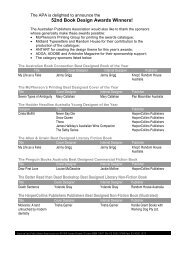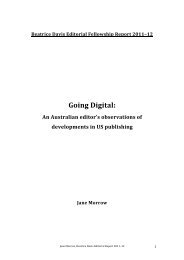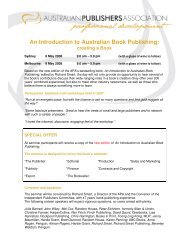Report 2013 - Kelly Fagan HERE - Australian Publishers Association
Report 2013 - Kelly Fagan HERE - Australian Publishers Association
Report 2013 - Kelly Fagan HERE - Australian Publishers Association
Create successful ePaper yourself
Turn your PDF publications into a flip-book with our unique Google optimized e-Paper software.
Overview<br />
With book marketing, everything has changed. We are now in the uncomfortable middle of not knowing<br />
what will work or what that even means. We don’t know. An uncomfortable middle needs then to be a<br />
time of great fear leading to passionate experimentation. The genetically-quotable Clay Shirky put it best<br />
when he said ‘Nothing will work. Everything might’.<br />
Kevin Shockey, O’Reilly Media<br />
Marketing and publicity for books has long been a subject of debate.<br />
The original proposal for this fellowship report was to research the role of marketing and publicity in a new,<br />
increasingly digitised publishing landscape. The scope of this project, and the issues at its heart, are vast. The very<br />
reason marketing and publicity is often called into question is that it is daunting, if not near impossible, to quantify<br />
their efficacy and relevancy with sheer numbers.<br />
Until recently most trade publishers have operated with a marketing department focused largely on retailer promotions<br />
and mass communication and a publicity department charged with promoting a book through traditional media<br />
channels and author tours that engage with readers directly. Today’s rapidly changing retail environment paired with<br />
continual consolidation of the traditional media, however, has challenged the way trade publishers have historically<br />
communicated with their readers forcing a re-evaluation of marketing and publicity roles within many of the major<br />
<strong>Australian</strong> houses.<br />
The rise of social media and direct digital marketing has afforded the industry the unprecedented opportunity<br />
to circumvent traditional media and speak directly to their consumers. The challenge now is how to market and<br />
publicise books effectively to an increasingly fragmented audience in a cost-effective and time-efficient manner<br />
across genres and retail spaces. In 2010, the <strong>Australian</strong> Government established the Book Industry Strategy<br />
Group (BISG) ‘to identify the key priority issues for addressing the need for structural change across the industry<br />
supply chain and to recommend appropriate actions to be taken to meet emerging challenges’. Among the key<br />
recommendations from the group was ‘to improve industry skills in marketing and communications’.<br />
This report aims to examine the more advanced UK book trade, and discuss how publishers there, are tackling<br />
the challenges associated with marketing and publicising books in a digitised world. Originally I had hoped to be<br />
able to perform some kind of empirical analysis on traditional marketing and publicity activities; however several<br />
things made this near impossible to achieve. Firstly, as with other Unwin Fellows before me, I found it impossible<br />
to organise an interview with Amazon, UK publishing’s largest customer. Without being able to speak directly to<br />
buyers and merchandisers within Amazon, it is almost impossible to measure the effect of marketing and publicity<br />
at a retail level. Compounding this issue was the reluctance of those people within publishing companies who sell<br />
to Amazon to talk about their processes. Furthermore, I found that looking at sales data on UK Bookscan (which<br />
doesn’t take into account e-book sales) also did not give an accurate picture of the performance of a particular title,<br />
and again publishers were especially careful around what information they would divulge with regards to e-book<br />
sales of particular titles.<br />
Due to these limitations, the report focuses mainly on the promotional strategies and activities of trade publishers –<br />
their value and also the ways in which they are changing. It should be noted that this report is primarily concerned<br />
with what I have called traditional marketing and publicity activities. Whilst some of my research did lead me to the<br />
new and very interesting areas of pricing and meta-data these activities still tend to fall outside the brief of trade<br />
marketing and publicity departments.<br />
With this in mind, I’ve identified what I hope are key areas of interest to <strong>Australian</strong> publishers (particularly marketers<br />
and publicists): comparing retail and media spaces between the two territories; looking at department structures;<br />
analysing the evolution of marketing and publicity strategy and activities within trade publishing houses; and<br />
attempting to answer the question of what it means for a publisher to connect directly with a consumer.<br />
Author: <strong>Kelly</strong> <strong>Fagan</strong><br />
1









